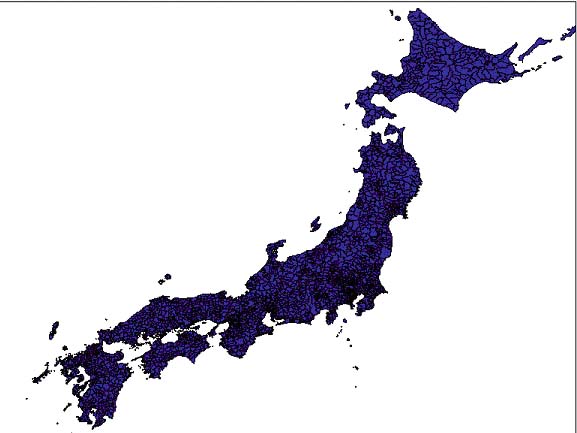JAPAN

Some basic facts on Japan according to the CIA Factbook
http://www.cia.gov/cia/publications/factbook/geos/ja.html
-
Total area of Japan is 377,835 sq km; it is slightly smaller
than California.
-
Four core islands exist: Hokkaido, Honshu, Shikoku and Kyushu.
-
Among them, Honshu has major concentration of population
and industrial centers such as Tokyo, Yokohama, Osaka, Kobe, Nagoya (Toyoya).
-
Japan is an advanced industrial nation and has several environmental
issues: air pollution from power plant emissions results in acid rain;
acidification of lakes and reservoirs degrading water quality and threatening
aquatic life.
-
Japan is one of the largest consumers of fish and tropical
timber, contributing to the depletion of these resources in Asia and elsewhere.
-
Japan's population is over 120 million (it is the about 8-10th
largest population in the world).
-
Japan is almost entirely racially homogeneous (99% are Japanese
and others are 1% (Korean 511,262, Chinese 244,241, Brazilian 182,232,
Filipino 89,851, other 237,914) (2000).
Research Questions:
-
Where are the most heavily polluted areas in Japan?
-
Who are the most disproportionately burdened by environmental
hazards esp. since the nation is virtually homogeneous?
-
What are some of the demographics that characterize the regions
that are most heavily polluted in Japan?
Data:
-
ArcView 3.2 Shapefile of Japan
(from ESRI Japan and University of Tokyo)
-3815 city/town/village divisions
-
Census Data (Japanese Census
Bureau)
-Data available at the city/town/village level (smallest)
-
Hazardous Waste Site Facility Locations
(Sanpai Net)
Some indepth information on Hazardous Waste Sites
in Japan
"Specially Controlled Waste Disposal Sites" in Japan
There are two types of waste disposal sites in Japan:
general waste disposal sites and 'specially controlled waste disposal sites.'
Both waste disposal facilities must obtain a permission from local governmental
authorities (special city or prefecture). As for the year 2000, 907
general waste disposal facilities (permanent waste management, thus it
does not include over 2000 temporal waste disposal sites) exist in Japan.
They deal with only less dangerous and non-toxic wastes that are not specified
in the list of the Ministry of Health and Labor. In the same year,
35 companies obtained permission for permanent specially controlled waste
disposal facilities. These companies can have facilities in more
than one regions with this permit. They can deal with highly toxic
wastes such as dioxin, poisoned industrial wastes, and virus infected medical
wastes. They must satisfy several requirements to be a facility for
this category.
These 'specially controlled waste disposal facilities'
are of three different types. They include:
-
1) Permanent 'specially controlled waste disposal
facilities' which are those hazardous waste facilities that are permanently
situated in an area and are likely to serve as the final destination in
which hazardous wastes end up;
-
2) Temporary 'specially controlled waste disposal
facilities' which are those that keep wastes for a limited amount of time
and are eventually moved to the final (permanent) disposal sites.
Sometimes wastes are transformed into a less toxic state here before they
are moved
-
3) Transporter 'specially controlled waste disposal
facilities' are points where transprotation companies collect wastes and
hold until they move to a temporary or final disposal site.
The data of the facilities in this analysis were taken from
the Japan Industrial Waste Management Foundation (the Sanpai-net).
This foundation is created for improvement and standardization of waste
management industry. The current data only covers the permanent
type 'specially controlled waste disposal sites.' In the data that
I have, I have the point locations for 72 permanent 'specially controlled
waste disposal sites' throughout the entire nation. (There are so
many more temporary and transporter 'specially controlled waste disposal
facilities' it would be almost impossible for me to locate them all for
this project.)
72 Permanently Specially Controlled
Waste Disposal Facilities in all of Japan ----LOOK HERE!!!!!!
Some preliminary analysis using the census data:
Number of Industrial Companies
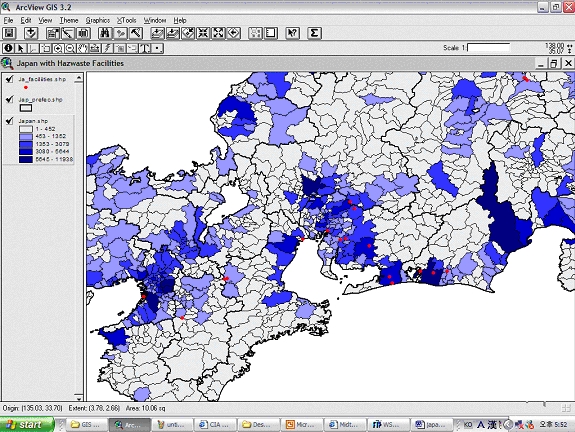
Seeing that the facility point
locations correspond to areas where there is a high number of industrial
companies locations can be a good cross check to make sure that the facilities
are in fact in areas that would 'make sense.' I would expect to see
the especially hazardous waste facilities to be in close proximity to a
high concentration of industrial companies and indeed, in this map, we
can see that this is true.
Percent Unemployed
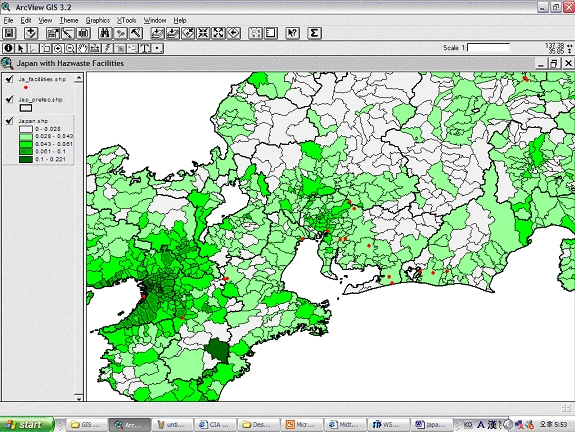
Nighttime Population
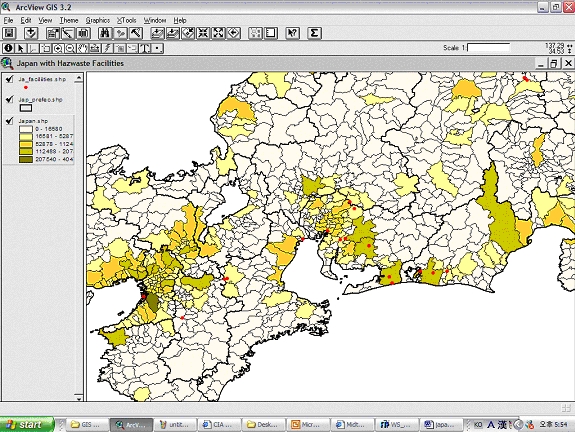
Conclusions Thus Far:
-
Need to control each variable to see the real factors that
determines the location of the hazardous waste facilities in Japan.
-
Based on the maps above, each of the variables (industrial
area, unemployment rate, residential area) tested seems to have an effect
In order to do a closer study of Japan, I have broken
up the nation into 8 regions as follows:
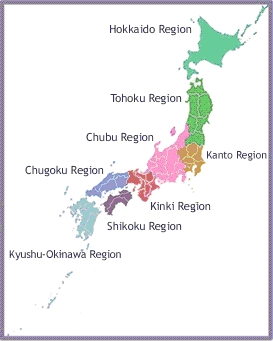
CLICK!!
A Preliminary Study at the Prefectural Level
Even within these 8 regions, it may be more meaningful
to look at an area at the prefectural level. At this point in time,
I have yet to discover which regions would be the most ideal areas for
this type of study. In order to take a first stab at figuring this
out, I have further conducted another preliminary study looking at a few
prefectures based on two hypothetical factors that are likely to affect
where facilities are likely to be sited in Japan. These two factors
are degree of industrialization and geography.
CLICK HERE TO SEE THIS STUDY!


